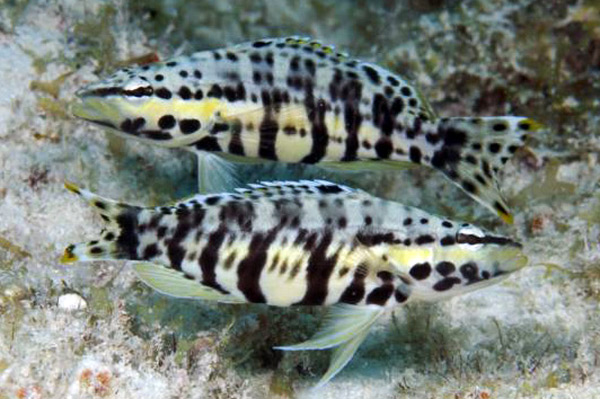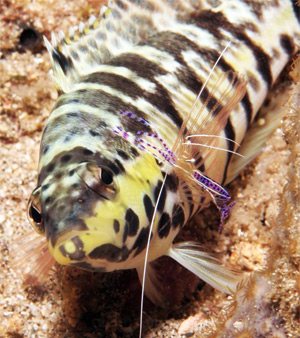Prized for its striking patterning, modest adult size, exceptional hardiness, and overall adaptability, the harlequin bass (Serranus tigrinus), denizen of the tropical western Atlantic and Caribbean, makes an excellent choice for the novice marine aquarist and experienced hobbyist alike. (In fact, just try to stop Caribbean Chris from keeping one!)
Physical traits
This fascinating dwarf seabass is white to gray overall with meandering black bands forming tiger stripes on its flanks and smaller black spots speckling the rest of its body, dorsal fin, and caudal fin. A yellowish tinge may also be evident on the ventral half of the body. The eyes are positioned high on the head, and the snout is long and tapers to form a point. Maximum size for this species is around 4 inches.
Feeding
A carnivore that, in nature, feeds primarily on small crustaceans, S. tigrinus will accept a wide range of small, meaty foods in captivity, such as frozen mysids and plankton, finely chopped crustacean or mollusk meat, various frozen commercial formulations for small predators (e.g., Fish Frenzy®), and so forth. Most specimens take to feeding in captivity with little difficulty, and once- or twice-daily feedings are recommended.

Housing
S. tigrinus doesn’t need a great deal of open swimming space, but it does require a decent amount of rockwork arranged to allow plenty of hideaways. The smallest tank that I believe can reasonably satisfy this requirement is around 30 gallons, though some sources put the minimum suggested tank size lower than that.
Compatibility
The harlequin bass is moderately aggressive with other fishes. It will likely coexist peacefully with tankmates that differ in appearance and size and don’t intrude too much on its territory (with the exception of really small fish, which it might eat), but this fish may squabble with similar species and those that attempt to occupy the same niche in the aquarium. Other dwarf seabass species are included in the best-omitted group, as are conspecifics unless you can be certain you’re acquiring a bonded pair.
S. tigrinus can be considered reef-safe, as the only invertebrates it might bother are very small crustaceans (remember, little crustaceans are largely what comprise the harlequin bass’s natural diet). It shouldn’t pester corals or other sessile invertebrates at all.




